Critical Disability Theory: Case Studies and Discussion
VerifiedAdded on 2020/02/18
|13
|4019
|166
Essay
AI Summary
This essay provides an in-depth exploration of Critical Disability Theory (CDT), a framework used to analyze disabilities, encompassing physical, psychological, neurological, and biomechanical aspects. It begins with an introduction to CDT, highlighting its significance in understanding the societal conditions of disabled individuals. The essay delves into the social model of disability, which challenges the notion that disability is solely an individual impairment, emphasizing the role of societal barriers in hindering the integration of disabled people. Case studies of Chelsie Hill and Sana illustrate how disability does not have the potential to shatter dreams and the importance of social awareness. The discussion section elaborates on CDT's origins, key elements like the social and medical models, multidimensionality, and the valuing of diversity. The social model is contrasted with the medical model, which focuses on medical interventions, and the essay emphasizes the importance of social acceptance and rights for disabled individuals. The essay underscores the role of language and legal frameworks in shaping perceptions and ensuring the rights of disabled people, advocating for a more inclusive society where disabled people can fully participate in all aspects of life.
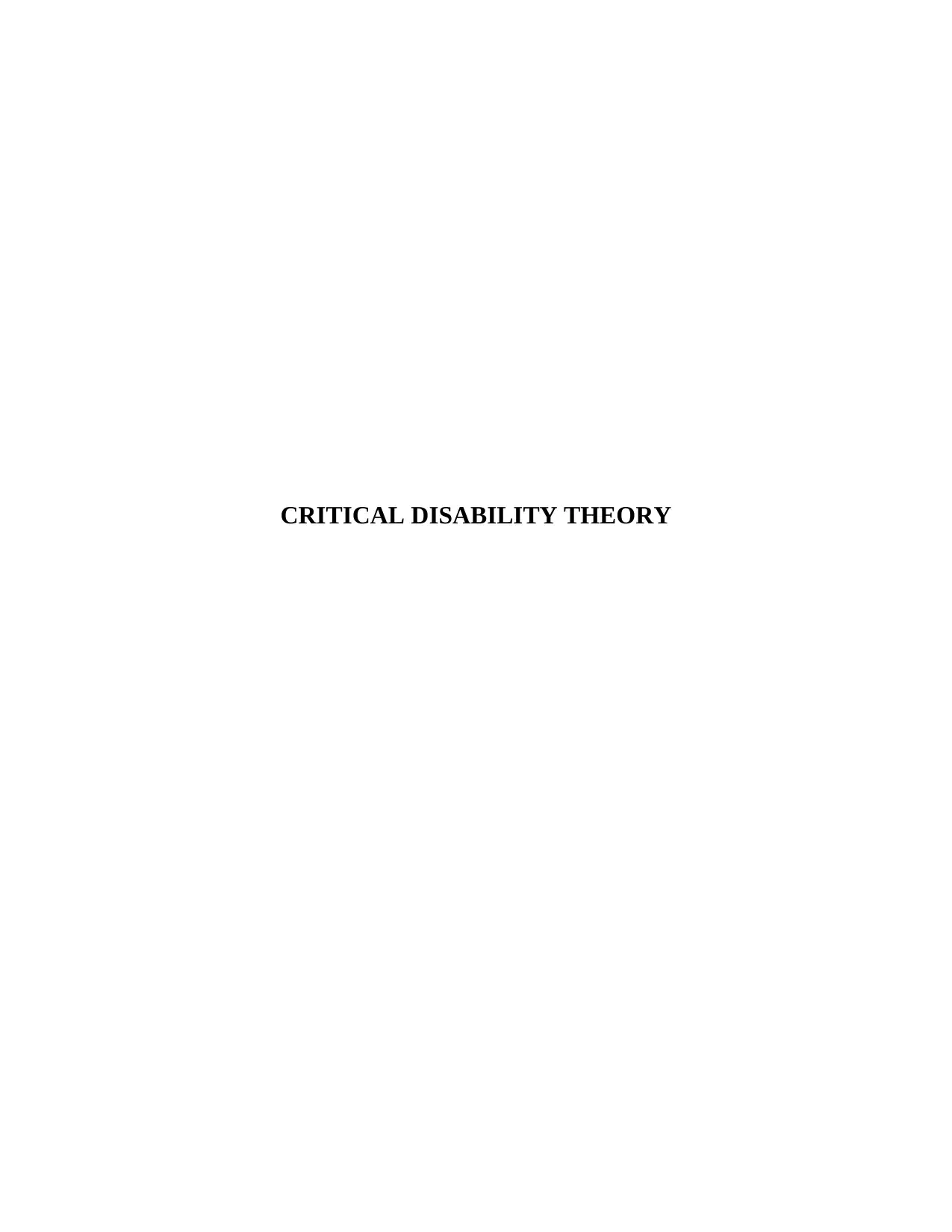
CRITICAL DISABILITY THEORY
Paraphrase This Document
Need a fresh take? Get an instant paraphrase of this document with our AI Paraphraser
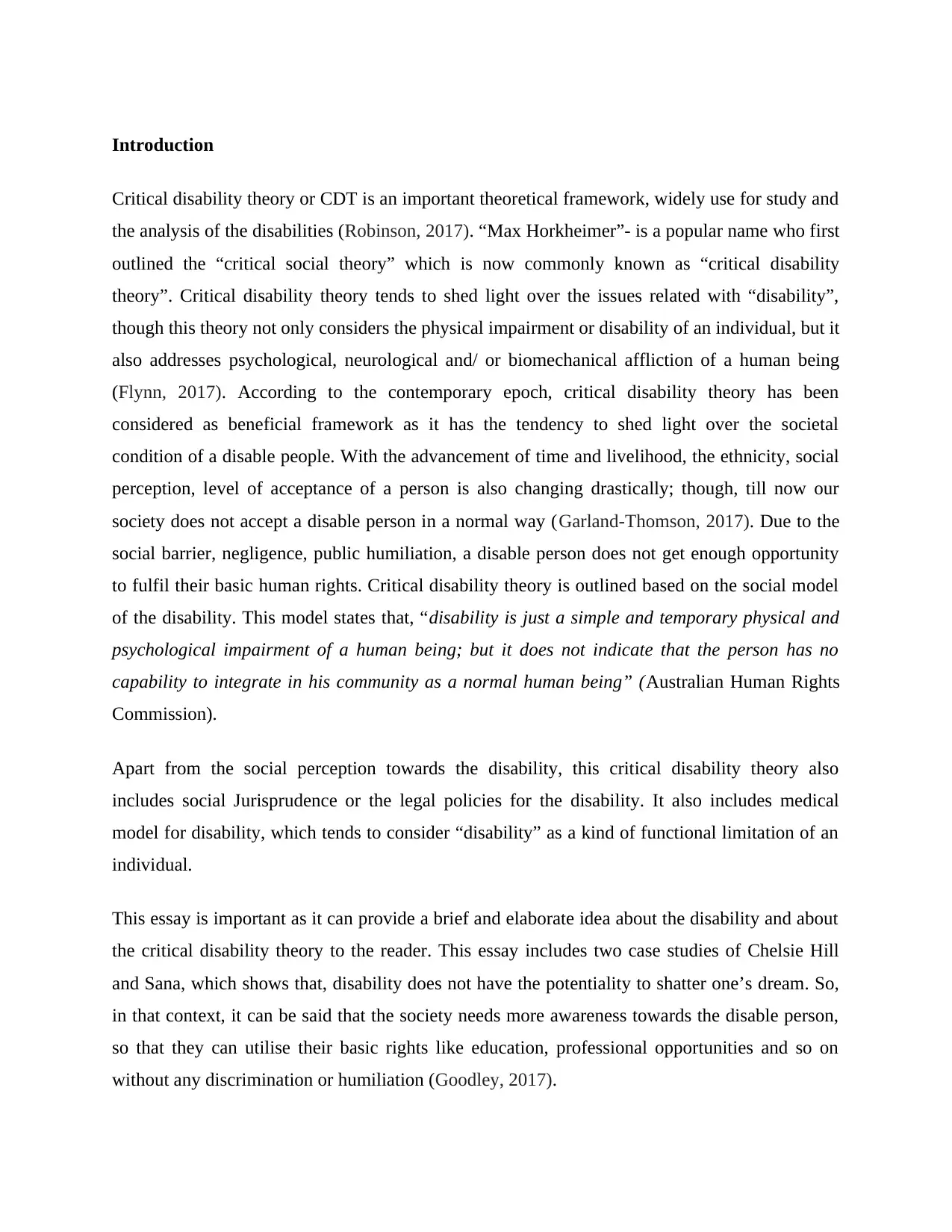
Introduction
Critical disability theory or CDT is an important theoretical framework, widely use for study and
the analysis of the disabilities (Robinson, 2017). “Max Horkheimer”- is a popular name who first
outlined the “critical social theory” which is now commonly known as “critical disability
theory”. Critical disability theory tends to shed light over the issues related with “disability”,
though this theory not only considers the physical impairment or disability of an individual, but it
also addresses psychological, neurological and/ or biomechanical affliction of a human being
(Flynn, 2017). According to the contemporary epoch, critical disability theory has been
considered as beneficial framework as it has the tendency to shed light over the societal
condition of a disable people. With the advancement of time and livelihood, the ethnicity, social
perception, level of acceptance of a person is also changing drastically; though, till now our
society does not accept a disable person in a normal way (Garland-Thomson, 2017). Due to the
social barrier, negligence, public humiliation, a disable person does not get enough opportunity
to fulfil their basic human rights. Critical disability theory is outlined based on the social model
of the disability. This model states that, “disability is just a simple and temporary physical and
psychological impairment of a human being; but it does not indicate that the person has no
capability to integrate in his community as a normal human being” (Australian Human Rights
Commission).
Apart from the social perception towards the disability, this critical disability theory also
includes social Jurisprudence or the legal policies for the disability. It also includes medical
model for disability, which tends to consider “disability” as a kind of functional limitation of an
individual.
This essay is important as it can provide a brief and elaborate idea about the disability and about
the critical disability theory to the reader. This essay includes two case studies of Chelsie Hill
and Sana, which shows that, disability does not have the potentiality to shatter one’s dream. So,
in that context, it can be said that the society needs more awareness towards the disable person,
so that they can utilise their basic rights like education, professional opportunities and so on
without any discrimination or humiliation (Goodley, 2017).
Critical disability theory or CDT is an important theoretical framework, widely use for study and
the analysis of the disabilities (Robinson, 2017). “Max Horkheimer”- is a popular name who first
outlined the “critical social theory” which is now commonly known as “critical disability
theory”. Critical disability theory tends to shed light over the issues related with “disability”,
though this theory not only considers the physical impairment or disability of an individual, but it
also addresses psychological, neurological and/ or biomechanical affliction of a human being
(Flynn, 2017). According to the contemporary epoch, critical disability theory has been
considered as beneficial framework as it has the tendency to shed light over the societal
condition of a disable people. With the advancement of time and livelihood, the ethnicity, social
perception, level of acceptance of a person is also changing drastically; though, till now our
society does not accept a disable person in a normal way (Garland-Thomson, 2017). Due to the
social barrier, negligence, public humiliation, a disable person does not get enough opportunity
to fulfil their basic human rights. Critical disability theory is outlined based on the social model
of the disability. This model states that, “disability is just a simple and temporary physical and
psychological impairment of a human being; but it does not indicate that the person has no
capability to integrate in his community as a normal human being” (Australian Human Rights
Commission).
Apart from the social perception towards the disability, this critical disability theory also
includes social Jurisprudence or the legal policies for the disability. It also includes medical
model for disability, which tends to consider “disability” as a kind of functional limitation of an
individual.
This essay is important as it can provide a brief and elaborate idea about the disability and about
the critical disability theory to the reader. This essay includes two case studies of Chelsie Hill
and Sana, which shows that, disability does not have the potentiality to shatter one’s dream. So,
in that context, it can be said that the society needs more awareness towards the disable person,
so that they can utilise their basic rights like education, professional opportunities and so on
without any discrimination or humiliation (Goodley, 2017).
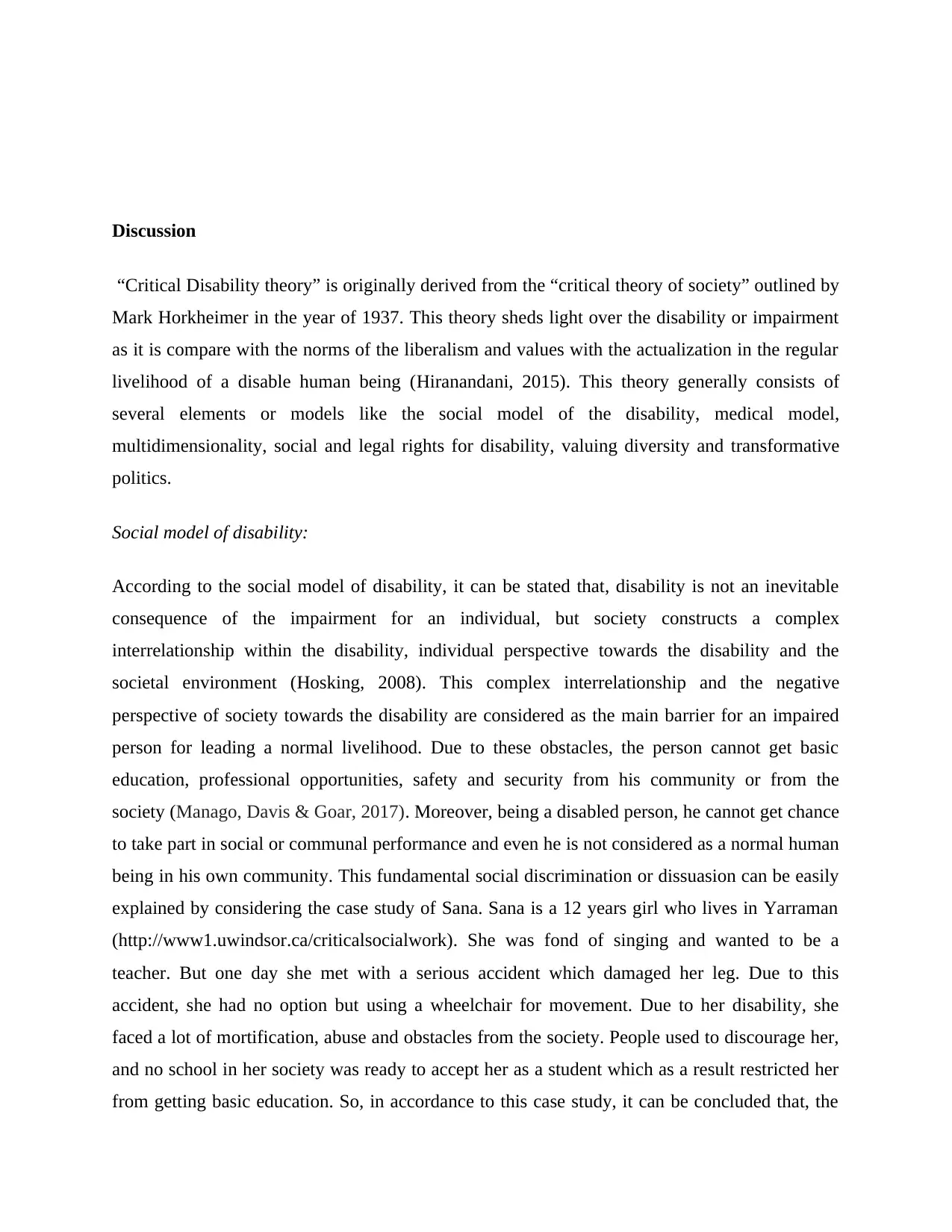
Discussion
“Critical Disability theory” is originally derived from the “critical theory of society” outlined by
Mark Horkheimer in the year of 1937. This theory sheds light over the disability or impairment
as it is compare with the norms of the liberalism and values with the actualization in the regular
livelihood of a disable human being (Hiranandani, 2015). This theory generally consists of
several elements or models like the social model of the disability, medical model,
multidimensionality, social and legal rights for disability, valuing diversity and transformative
politics.
Social model of disability:
According to the social model of disability, it can be stated that, disability is not an inevitable
consequence of the impairment for an individual, but society constructs a complex
interrelationship within the disability, individual perspective towards the disability and the
societal environment (Hosking, 2008). This complex interrelationship and the negative
perspective of society towards the disability are considered as the main barrier for an impaired
person for leading a normal livelihood. Due to these obstacles, the person cannot get basic
education, professional opportunities, safety and security from his community or from the
society (Manago, Davis & Goar, 2017). Moreover, being a disabled person, he cannot get chance
to take part in social or communal performance and even he is not considered as a normal human
being in his own community. This fundamental social discrimination or dissuasion can be easily
explained by considering the case study of Sana. Sana is a 12 years girl who lives in Yarraman
(http://www1.uwindsor.ca/criticalsocialwork). She was fond of singing and wanted to be a
teacher. But one day she met with a serious accident which damaged her leg. Due to this
accident, she had no option but using a wheelchair for movement. Due to her disability, she
faced a lot of mortification, abuse and obstacles from the society. People used to discourage her,
and no school in her society was ready to accept her as a student which as a result restricted her
from getting basic education. So, in accordance to this case study, it can be concluded that, the
“Critical Disability theory” is originally derived from the “critical theory of society” outlined by
Mark Horkheimer in the year of 1937. This theory sheds light over the disability or impairment
as it is compare with the norms of the liberalism and values with the actualization in the regular
livelihood of a disable human being (Hiranandani, 2015). This theory generally consists of
several elements or models like the social model of the disability, medical model,
multidimensionality, social and legal rights for disability, valuing diversity and transformative
politics.
Social model of disability:
According to the social model of disability, it can be stated that, disability is not an inevitable
consequence of the impairment for an individual, but society constructs a complex
interrelationship within the disability, individual perspective towards the disability and the
societal environment (Hosking, 2008). This complex interrelationship and the negative
perspective of society towards the disability are considered as the main barrier for an impaired
person for leading a normal livelihood. Due to these obstacles, the person cannot get basic
education, professional opportunities, safety and security from his community or from the
society (Manago, Davis & Goar, 2017). Moreover, being a disabled person, he cannot get chance
to take part in social or communal performance and even he is not considered as a normal human
being in his own community. This fundamental social discrimination or dissuasion can be easily
explained by considering the case study of Sana. Sana is a 12 years girl who lives in Yarraman
(http://www1.uwindsor.ca/criticalsocialwork). She was fond of singing and wanted to be a
teacher. But one day she met with a serious accident which damaged her leg. Due to this
accident, she had no option but using a wheelchair for movement. Due to her disability, she
faced a lot of mortification, abuse and obstacles from the society. People used to discourage her,
and no school in her society was ready to accept her as a student which as a result restricted her
from getting basic education. So, in accordance to this case study, it can be concluded that, the
⊘ This is a preview!⊘
Do you want full access?
Subscribe today to unlock all pages.

Trusted by 1+ million students worldwide
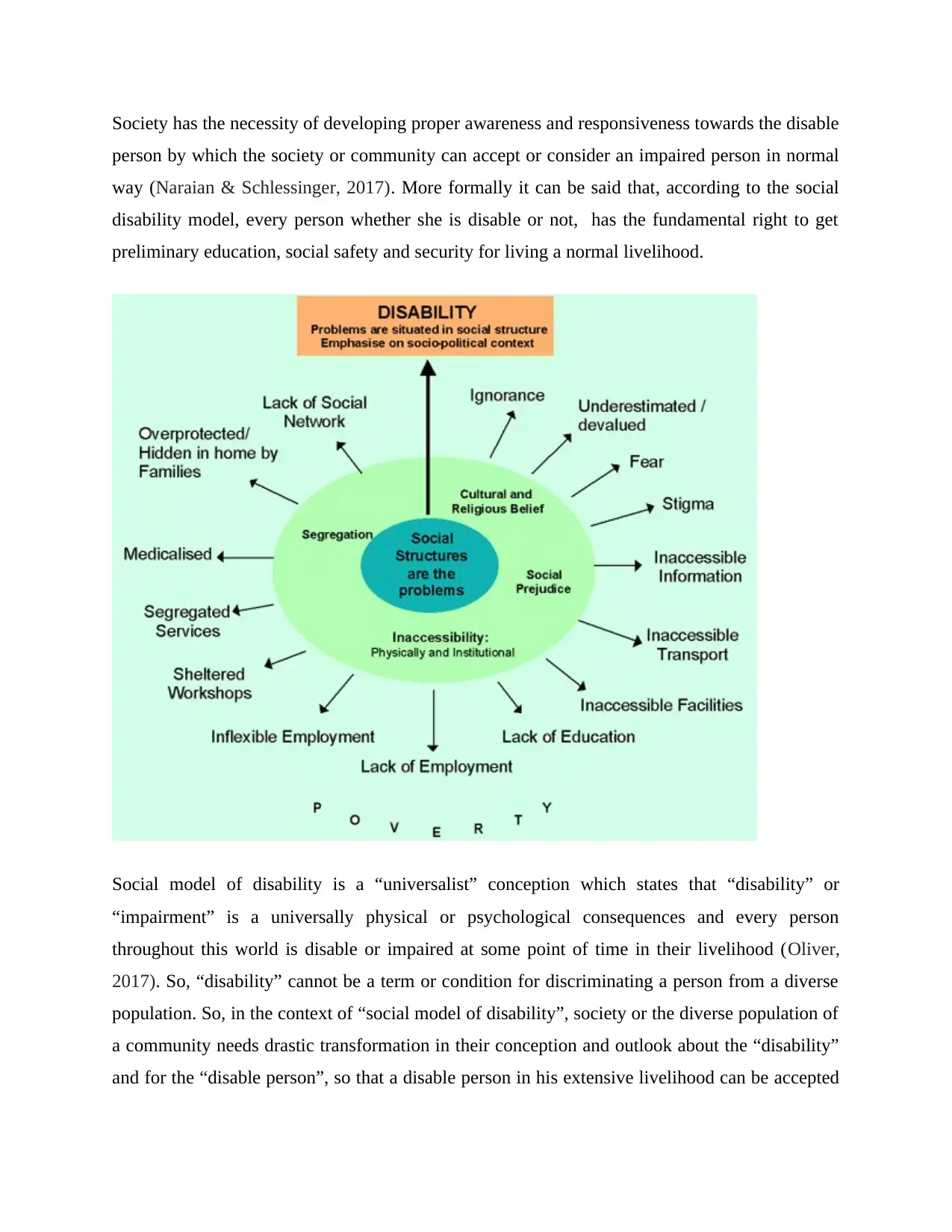
Society has the necessity of developing proper awareness and responsiveness towards the disable
person by which the society or community can accept or consider an impaired person in normal
way (Naraian & Schlessinger, 2017). More formally it can be said that, according to the social
disability model, every person whether she is disable or not, has the fundamental right to get
preliminary education, social safety and security for living a normal livelihood.
Social model of disability is a “universalist” conception which states that “disability” or
“impairment” is a universally physical or psychological consequences and every person
throughout this world is disable or impaired at some point of time in their livelihood (Oliver,
2017). So, “disability” cannot be a term or condition for discriminating a person from a diverse
population. So, in the context of “social model of disability”, society or the diverse population of
a community needs drastic transformation in their conception and outlook about the “disability”
and for the “disable person”, so that a disable person in his extensive livelihood can be accepted
person by which the society or community can accept or consider an impaired person in normal
way (Naraian & Schlessinger, 2017). More formally it can be said that, according to the social
disability model, every person whether she is disable or not, has the fundamental right to get
preliminary education, social safety and security for living a normal livelihood.
Social model of disability is a “universalist” conception which states that “disability” or
“impairment” is a universally physical or psychological consequences and every person
throughout this world is disable or impaired at some point of time in their livelihood (Oliver,
2017). So, “disability” cannot be a term or condition for discriminating a person from a diverse
population. So, in the context of “social model of disability”, society or the diverse population of
a community needs drastic transformation in their conception and outlook about the “disability”
and for the “disable person”, so that a disable person in his extensive livelihood can be accepted
Paraphrase This Document
Need a fresh take? Get an instant paraphrase of this document with our AI Paraphraser
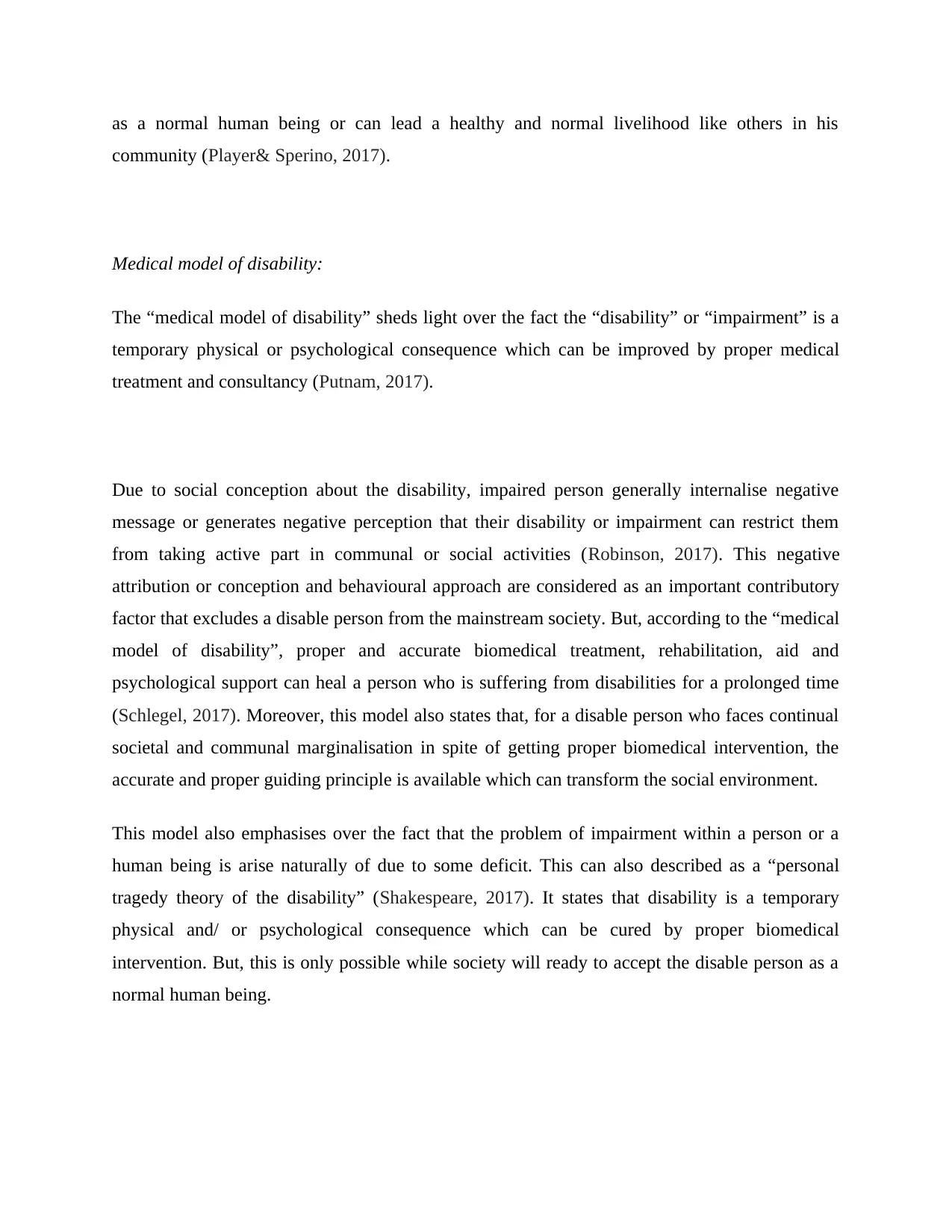
as a normal human being or can lead a healthy and normal livelihood like others in his
community (Player& Sperino, 2017).
Medical model of disability:
The “medical model of disability” sheds light over the fact the “disability” or “impairment” is a
temporary physical or psychological consequence which can be improved by proper medical
treatment and consultancy (Putnam, 2017).
Due to social conception about the disability, impaired person generally internalise negative
message or generates negative perception that their disability or impairment can restrict them
from taking active part in communal or social activities (Robinson, 2017). This negative
attribution or conception and behavioural approach are considered as an important contributory
factor that excludes a disable person from the mainstream society. But, according to the “medical
model of disability”, proper and accurate biomedical treatment, rehabilitation, aid and
psychological support can heal a person who is suffering from disabilities for a prolonged time
(Schlegel, 2017). Moreover, this model also states that, for a disable person who faces continual
societal and communal marginalisation in spite of getting proper biomedical intervention, the
accurate and proper guiding principle is available which can transform the social environment.
This model also emphasises over the fact that the problem of impairment within a person or a
human being is arise naturally of due to some deficit. This can also described as a “personal
tragedy theory of the disability” (Shakespeare, 2017). It states that disability is a temporary
physical and/ or psychological consequence which can be cured by proper biomedical
intervention. But, this is only possible while society will ready to accept the disable person as a
normal human being.
community (Player& Sperino, 2017).
Medical model of disability:
The “medical model of disability” sheds light over the fact the “disability” or “impairment” is a
temporary physical or psychological consequence which can be improved by proper medical
treatment and consultancy (Putnam, 2017).
Due to social conception about the disability, impaired person generally internalise negative
message or generates negative perception that their disability or impairment can restrict them
from taking active part in communal or social activities (Robinson, 2017). This negative
attribution or conception and behavioural approach are considered as an important contributory
factor that excludes a disable person from the mainstream society. But, according to the “medical
model of disability”, proper and accurate biomedical treatment, rehabilitation, aid and
psychological support can heal a person who is suffering from disabilities for a prolonged time
(Schlegel, 2017). Moreover, this model also states that, for a disable person who faces continual
societal and communal marginalisation in spite of getting proper biomedical intervention, the
accurate and proper guiding principle is available which can transform the social environment.
This model also emphasises over the fact that the problem of impairment within a person or a
human being is arise naturally of due to some deficit. This can also described as a “personal
tragedy theory of the disability” (Shakespeare, 2017). It states that disability is a temporary
physical and/ or psychological consequence which can be cured by proper biomedical
intervention. But, this is only possible while society will ready to accept the disable person as a
normal human being.
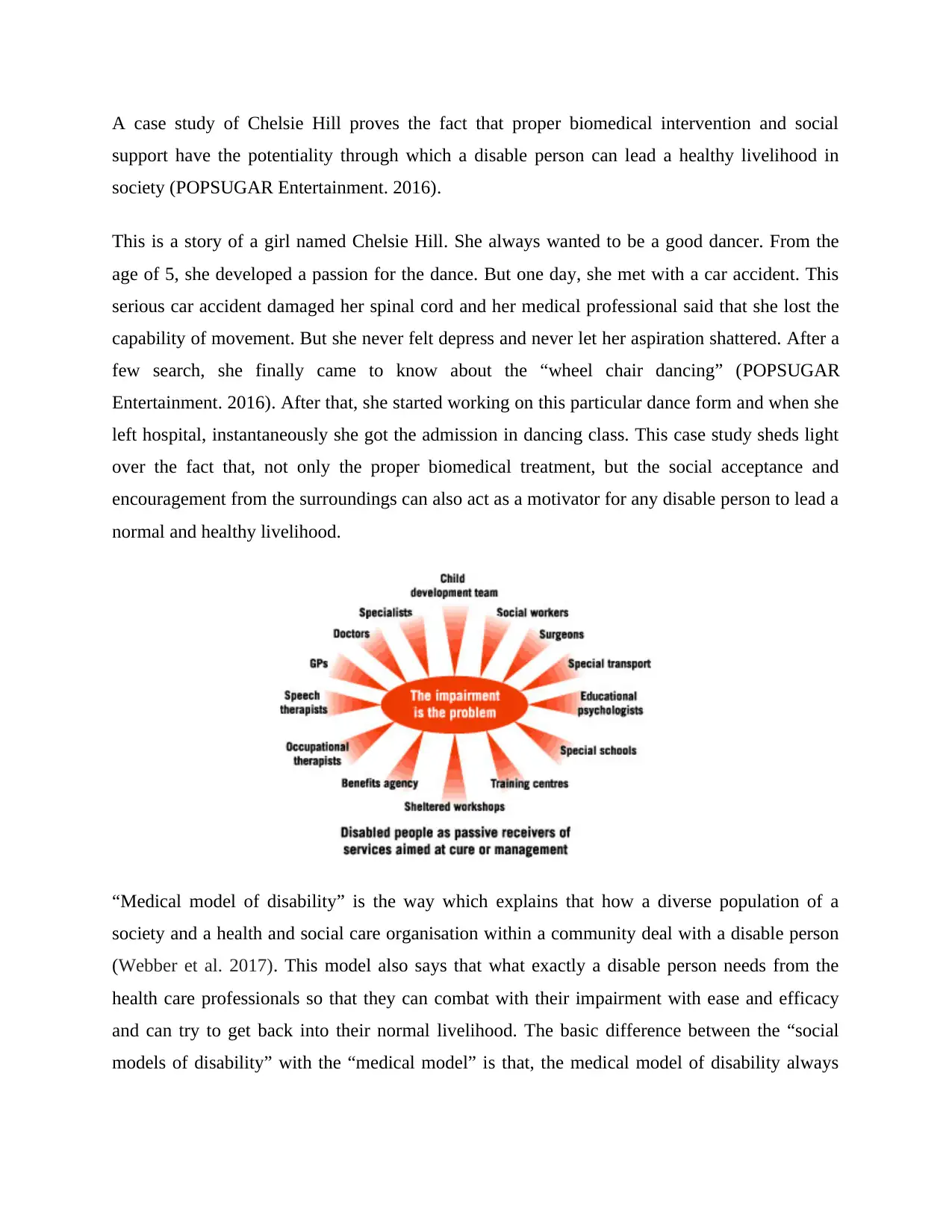
A case study of Chelsie Hill proves the fact that proper biomedical intervention and social
support have the potentiality through which a disable person can lead a healthy livelihood in
society (POPSUGAR Entertainment. 2016).
This is a story of a girl named Chelsie Hill. She always wanted to be a good dancer. From the
age of 5, she developed a passion for the dance. But one day, she met with a car accident. This
serious car accident damaged her spinal cord and her medical professional said that she lost the
capability of movement. But she never felt depress and never let her aspiration shattered. After a
few search, she finally came to know about the “wheel chair dancing” (POPSUGAR
Entertainment. 2016). After that, she started working on this particular dance form and when she
left hospital, instantaneously she got the admission in dancing class. This case study sheds light
over the fact that, not only the proper biomedical treatment, but the social acceptance and
encouragement from the surroundings can also act as a motivator for any disable person to lead a
normal and healthy livelihood.
“Medical model of disability” is the way which explains that how a diverse population of a
society and a health and social care organisation within a community deal with a disable person
(Webber et al. 2017). This model also says that what exactly a disable person needs from the
health care professionals so that they can combat with their impairment with ease and efficacy
and can try to get back into their normal livelihood. The basic difference between the “social
models of disability” with the “medical model” is that, the medical model of disability always
support have the potentiality through which a disable person can lead a healthy livelihood in
society (POPSUGAR Entertainment. 2016).
This is a story of a girl named Chelsie Hill. She always wanted to be a good dancer. From the
age of 5, she developed a passion for the dance. But one day, she met with a car accident. This
serious car accident damaged her spinal cord and her medical professional said that she lost the
capability of movement. But she never felt depress and never let her aspiration shattered. After a
few search, she finally came to know about the “wheel chair dancing” (POPSUGAR
Entertainment. 2016). After that, she started working on this particular dance form and when she
left hospital, instantaneously she got the admission in dancing class. This case study sheds light
over the fact that, not only the proper biomedical treatment, but the social acceptance and
encouragement from the surroundings can also act as a motivator for any disable person to lead a
normal and healthy livelihood.
“Medical model of disability” is the way which explains that how a diverse population of a
society and a health and social care organisation within a community deal with a disable person
(Webber et al. 2017). This model also says that what exactly a disable person needs from the
health care professionals so that they can combat with their impairment with ease and efficacy
and can try to get back into their normal livelihood. The basic difference between the “social
models of disability” with the “medical model” is that, the medical model of disability always
⊘ This is a preview!⊘
Do you want full access?
Subscribe today to unlock all pages.

Trusted by 1+ million students worldwide
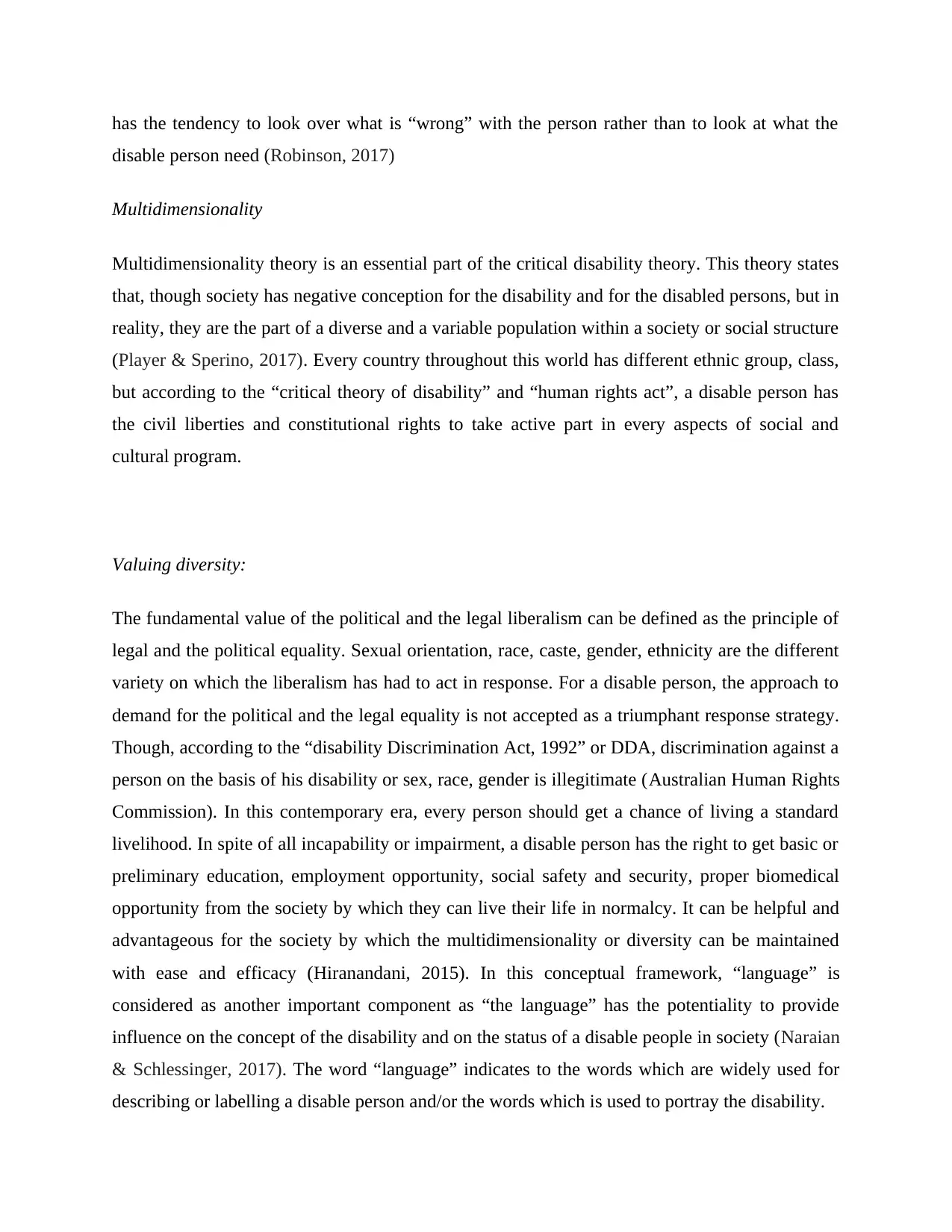
has the tendency to look over what is “wrong” with the person rather than to look at what the
disable person need (Robinson, 2017)
Multidimensionality
Multidimensionality theory is an essential part of the critical disability theory. This theory states
that, though society has negative conception for the disability and for the disabled persons, but in
reality, they are the part of a diverse and a variable population within a society or social structure
(Player & Sperino, 2017). Every country throughout this world has different ethnic group, class,
but according to the “critical theory of disability” and “human rights act”, a disable person has
the civil liberties and constitutional rights to take active part in every aspects of social and
cultural program.
Valuing diversity:
The fundamental value of the political and the legal liberalism can be defined as the principle of
legal and the political equality. Sexual orientation, race, caste, gender, ethnicity are the different
variety on which the liberalism has had to act in response. For a disable person, the approach to
demand for the political and the legal equality is not accepted as a triumphant response strategy.
Though, according to the “disability Discrimination Act, 1992” or DDA, discrimination against a
person on the basis of his disability or sex, race, gender is illegitimate (Australian Human Rights
Commission). In this contemporary era, every person should get a chance of living a standard
livelihood. In spite of all incapability or impairment, a disable person has the right to get basic or
preliminary education, employment opportunity, social safety and security, proper biomedical
opportunity from the society by which they can live their life in normalcy. It can be helpful and
advantageous for the society by which the multidimensionality or diversity can be maintained
with ease and efficacy (Hiranandani, 2015). In this conceptual framework, “language” is
considered as another important component as “the language” has the potentiality to provide
influence on the concept of the disability and on the status of a disable people in society (Naraian
& Schlessinger, 2017). The word “language” indicates to the words which are widely used for
describing or labelling a disable person and/or the words which is used to portray the disability.
disable person need (Robinson, 2017)
Multidimensionality
Multidimensionality theory is an essential part of the critical disability theory. This theory states
that, though society has negative conception for the disability and for the disabled persons, but in
reality, they are the part of a diverse and a variable population within a society or social structure
(Player & Sperino, 2017). Every country throughout this world has different ethnic group, class,
but according to the “critical theory of disability” and “human rights act”, a disable person has
the civil liberties and constitutional rights to take active part in every aspects of social and
cultural program.
Valuing diversity:
The fundamental value of the political and the legal liberalism can be defined as the principle of
legal and the political equality. Sexual orientation, race, caste, gender, ethnicity are the different
variety on which the liberalism has had to act in response. For a disable person, the approach to
demand for the political and the legal equality is not accepted as a triumphant response strategy.
Though, according to the “disability Discrimination Act, 1992” or DDA, discrimination against a
person on the basis of his disability or sex, race, gender is illegitimate (Australian Human Rights
Commission). In this contemporary era, every person should get a chance of living a standard
livelihood. In spite of all incapability or impairment, a disable person has the right to get basic or
preliminary education, employment opportunity, social safety and security, proper biomedical
opportunity from the society by which they can live their life in normalcy. It can be helpful and
advantageous for the society by which the multidimensionality or diversity can be maintained
with ease and efficacy (Hiranandani, 2015). In this conceptual framework, “language” is
considered as another important component as “the language” has the potentiality to provide
influence on the concept of the disability and on the status of a disable people in society (Naraian
& Schlessinger, 2017). The word “language” indicates to the words which are widely used for
describing or labelling a disable person and/or the words which is used to portray the disability.
Paraphrase This Document
Need a fresh take? Get an instant paraphrase of this document with our AI Paraphraser
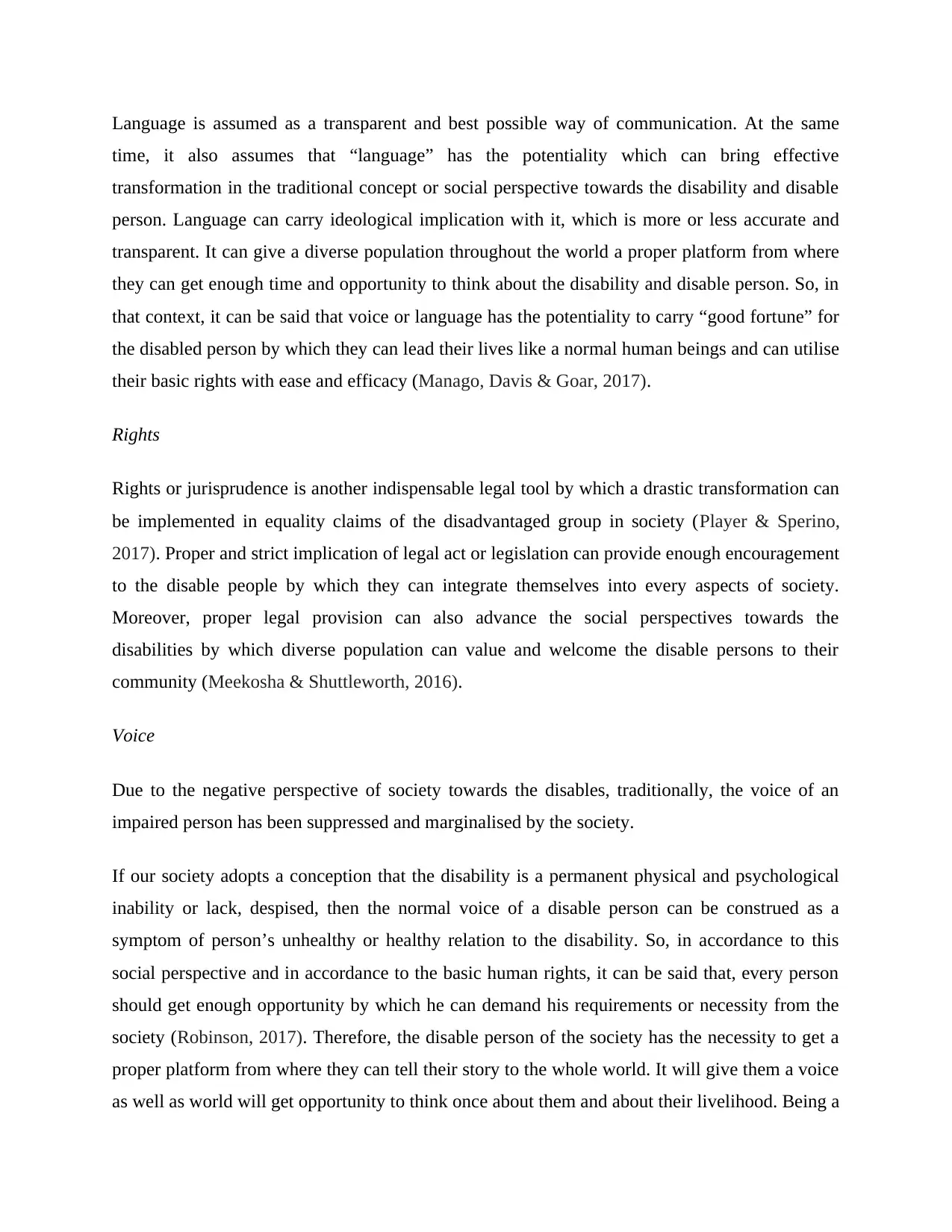
Language is assumed as a transparent and best possible way of communication. At the same
time, it also assumes that “language” has the potentiality which can bring effective
transformation in the traditional concept or social perspective towards the disability and disable
person. Language can carry ideological implication with it, which is more or less accurate and
transparent. It can give a diverse population throughout the world a proper platform from where
they can get enough time and opportunity to think about the disability and disable person. So, in
that context, it can be said that voice or language has the potentiality to carry “good fortune” for
the disabled person by which they can lead their lives like a normal human beings and can utilise
their basic rights with ease and efficacy (Manago, Davis & Goar, 2017).
Rights
Rights or jurisprudence is another indispensable legal tool by which a drastic transformation can
be implemented in equality claims of the disadvantaged group in society (Player & Sperino,
2017). Proper and strict implication of legal act or legislation can provide enough encouragement
to the disable people by which they can integrate themselves into every aspects of society.
Moreover, proper legal provision can also advance the social perspectives towards the
disabilities by which diverse population can value and welcome the disable persons to their
community (Meekosha & Shuttleworth, 2016).
Voice
Due to the negative perspective of society towards the disables, traditionally, the voice of an
impaired person has been suppressed and marginalised by the society.
If our society adopts a conception that the disability is a permanent physical and psychological
inability or lack, despised, then the normal voice of a disable person can be construed as a
symptom of person’s unhealthy or healthy relation to the disability. So, in accordance to this
social perspective and in accordance to the basic human rights, it can be said that, every person
should get enough opportunity by which he can demand his requirements or necessity from the
society (Robinson, 2017). Therefore, the disable person of the society has the necessity to get a
proper platform from where they can tell their story to the whole world. It will give them a voice
as well as world will get opportunity to think once about them and about their livelihood. Being a
time, it also assumes that “language” has the potentiality which can bring effective
transformation in the traditional concept or social perspective towards the disability and disable
person. Language can carry ideological implication with it, which is more or less accurate and
transparent. It can give a diverse population throughout the world a proper platform from where
they can get enough time and opportunity to think about the disability and disable person. So, in
that context, it can be said that voice or language has the potentiality to carry “good fortune” for
the disabled person by which they can lead their lives like a normal human beings and can utilise
their basic rights with ease and efficacy (Manago, Davis & Goar, 2017).
Rights
Rights or jurisprudence is another indispensable legal tool by which a drastic transformation can
be implemented in equality claims of the disadvantaged group in society (Player & Sperino,
2017). Proper and strict implication of legal act or legislation can provide enough encouragement
to the disable people by which they can integrate themselves into every aspects of society.
Moreover, proper legal provision can also advance the social perspectives towards the
disabilities by which diverse population can value and welcome the disable persons to their
community (Meekosha & Shuttleworth, 2016).
Voice
Due to the negative perspective of society towards the disables, traditionally, the voice of an
impaired person has been suppressed and marginalised by the society.
If our society adopts a conception that the disability is a permanent physical and psychological
inability or lack, despised, then the normal voice of a disable person can be construed as a
symptom of person’s unhealthy or healthy relation to the disability. So, in accordance to this
social perspective and in accordance to the basic human rights, it can be said that, every person
should get enough opportunity by which he can demand his requirements or necessity from the
society (Robinson, 2017). Therefore, the disable person of the society has the necessity to get a
proper platform from where they can tell their story to the whole world. It will give them a voice
as well as world will get opportunity to think once about them and about their livelihood. Being a
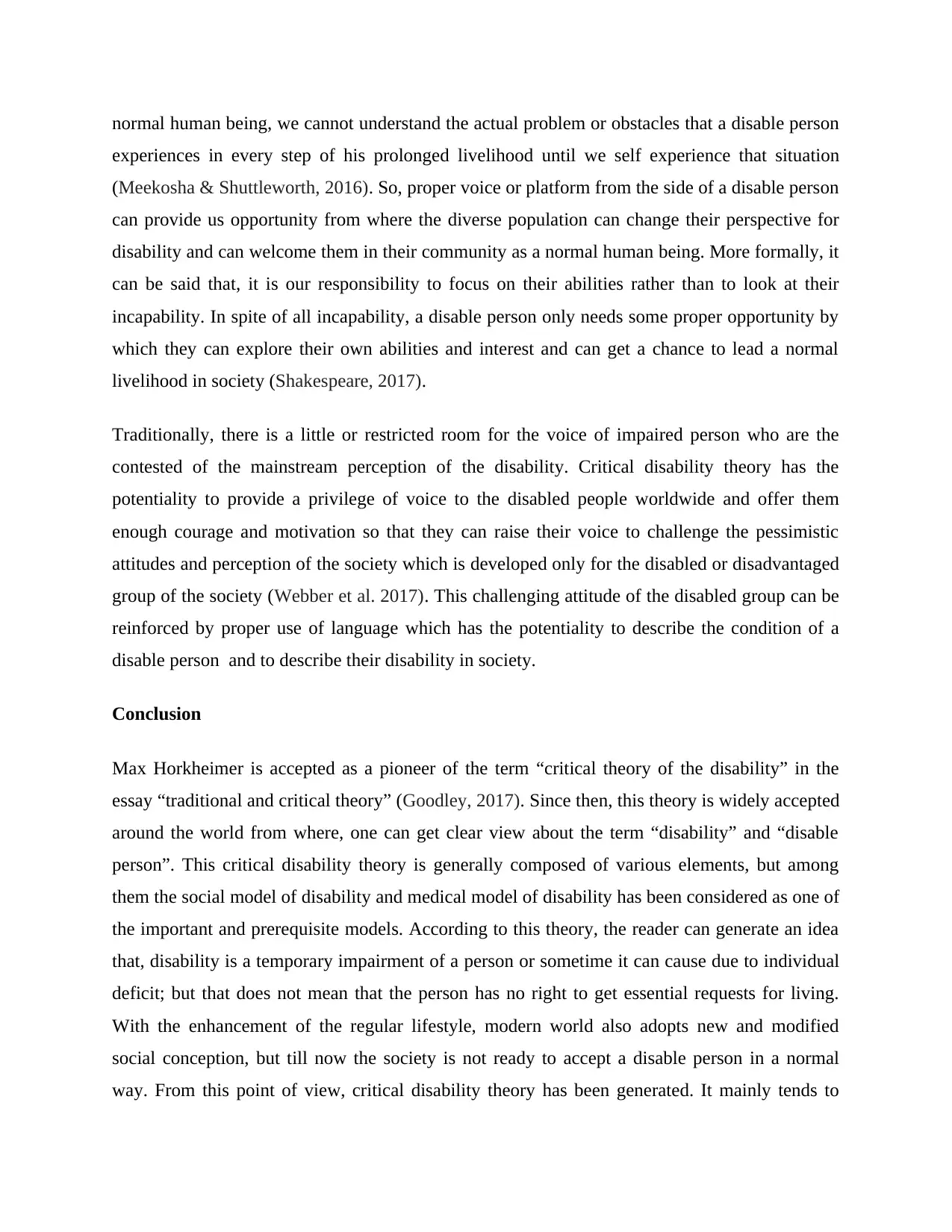
normal human being, we cannot understand the actual problem or obstacles that a disable person
experiences in every step of his prolonged livelihood until we self experience that situation
(Meekosha & Shuttleworth, 2016). So, proper voice or platform from the side of a disable person
can provide us opportunity from where the diverse population can change their perspective for
disability and can welcome them in their community as a normal human being. More formally, it
can be said that, it is our responsibility to focus on their abilities rather than to look at their
incapability. In spite of all incapability, a disable person only needs some proper opportunity by
which they can explore their own abilities and interest and can get a chance to lead a normal
livelihood in society (Shakespeare, 2017).
Traditionally, there is a little or restricted room for the voice of impaired person who are the
contested of the mainstream perception of the disability. Critical disability theory has the
potentiality to provide a privilege of voice to the disabled people worldwide and offer them
enough courage and motivation so that they can raise their voice to challenge the pessimistic
attitudes and perception of the society which is developed only for the disabled or disadvantaged
group of the society (Webber et al. 2017). This challenging attitude of the disabled group can be
reinforced by proper use of language which has the potentiality to describe the condition of a
disable person and to describe their disability in society.
Conclusion
Max Horkheimer is accepted as a pioneer of the term “critical theory of the disability” in the
essay “traditional and critical theory” (Goodley, 2017). Since then, this theory is widely accepted
around the world from where, one can get clear view about the term “disability” and “disable
person”. This critical disability theory is generally composed of various elements, but among
them the social model of disability and medical model of disability has been considered as one of
the important and prerequisite models. According to this theory, the reader can generate an idea
that, disability is a temporary impairment of a person or sometime it can cause due to individual
deficit; but that does not mean that the person has no right to get essential requests for living.
With the enhancement of the regular lifestyle, modern world also adopts new and modified
social conception, but till now the society is not ready to accept a disable person in a normal
way. From this point of view, critical disability theory has been generated. It mainly tends to
experiences in every step of his prolonged livelihood until we self experience that situation
(Meekosha & Shuttleworth, 2016). So, proper voice or platform from the side of a disable person
can provide us opportunity from where the diverse population can change their perspective for
disability and can welcome them in their community as a normal human being. More formally, it
can be said that, it is our responsibility to focus on their abilities rather than to look at their
incapability. In spite of all incapability, a disable person only needs some proper opportunity by
which they can explore their own abilities and interest and can get a chance to lead a normal
livelihood in society (Shakespeare, 2017).
Traditionally, there is a little or restricted room for the voice of impaired person who are the
contested of the mainstream perception of the disability. Critical disability theory has the
potentiality to provide a privilege of voice to the disabled people worldwide and offer them
enough courage and motivation so that they can raise their voice to challenge the pessimistic
attitudes and perception of the society which is developed only for the disabled or disadvantaged
group of the society (Webber et al. 2017). This challenging attitude of the disabled group can be
reinforced by proper use of language which has the potentiality to describe the condition of a
disable person and to describe their disability in society.
Conclusion
Max Horkheimer is accepted as a pioneer of the term “critical theory of the disability” in the
essay “traditional and critical theory” (Goodley, 2017). Since then, this theory is widely accepted
around the world from where, one can get clear view about the term “disability” and “disable
person”. This critical disability theory is generally composed of various elements, but among
them the social model of disability and medical model of disability has been considered as one of
the important and prerequisite models. According to this theory, the reader can generate an idea
that, disability is a temporary impairment of a person or sometime it can cause due to individual
deficit; but that does not mean that the person has no right to get essential requests for living.
With the enhancement of the regular lifestyle, modern world also adopts new and modified
social conception, but till now the society is not ready to accept a disable person in a normal
way. From this point of view, critical disability theory has been generated. It mainly tends to
⊘ This is a preview!⊘
Do you want full access?
Subscribe today to unlock all pages.

Trusted by 1+ million students worldwide
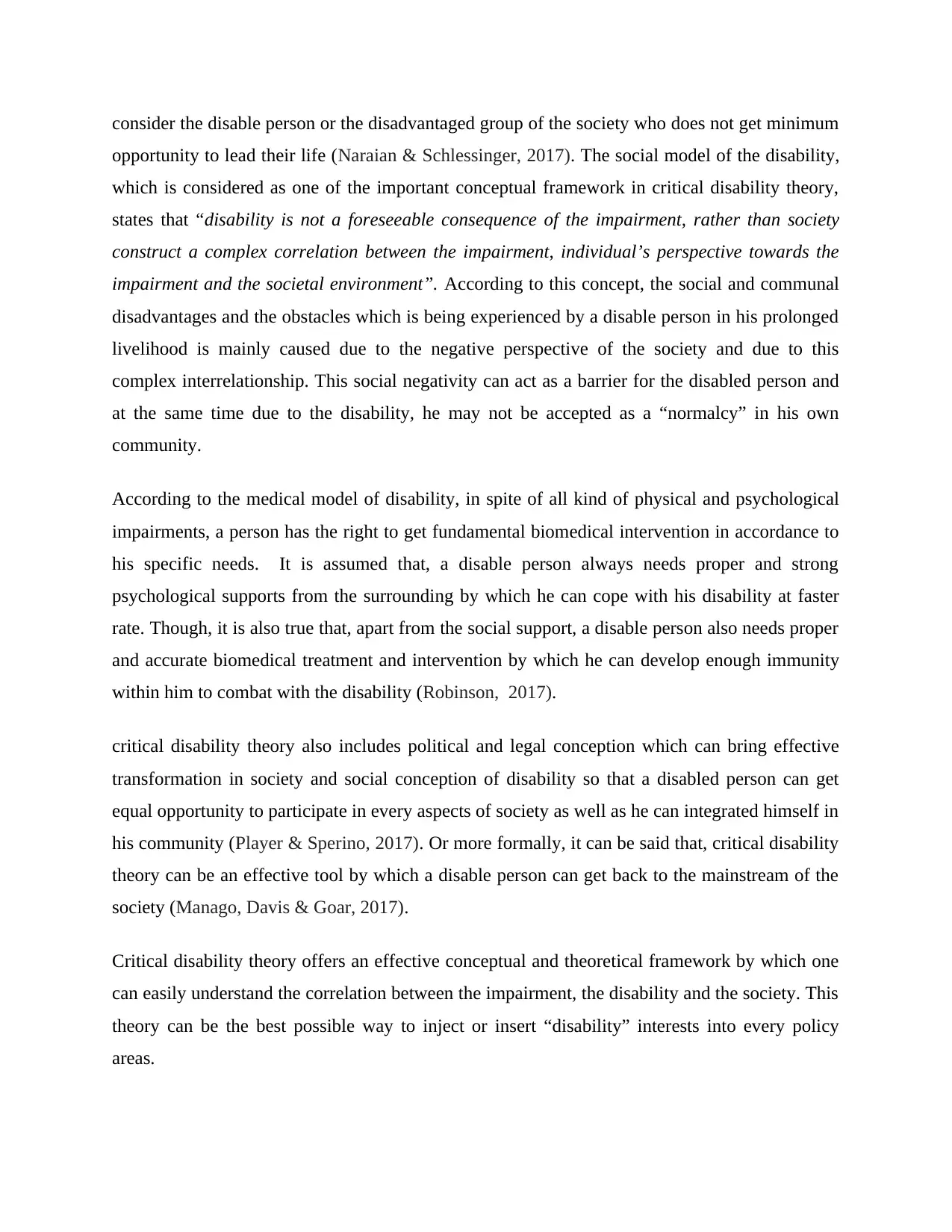
consider the disable person or the disadvantaged group of the society who does not get minimum
opportunity to lead their life (Naraian & Schlessinger, 2017). The social model of the disability,
which is considered as one of the important conceptual framework in critical disability theory,
states that “disability is not a foreseeable consequence of the impairment, rather than society
construct a complex correlation between the impairment, individual’s perspective towards the
impairment and the societal environment”. According to this concept, the social and communal
disadvantages and the obstacles which is being experienced by a disable person in his prolonged
livelihood is mainly caused due to the negative perspective of the society and due to this
complex interrelationship. This social negativity can act as a barrier for the disabled person and
at the same time due to the disability, he may not be accepted as a “normalcy” in his own
community.
According to the medical model of disability, in spite of all kind of physical and psychological
impairments, a person has the right to get fundamental biomedical intervention in accordance to
his specific needs. It is assumed that, a disable person always needs proper and strong
psychological supports from the surrounding by which he can cope with his disability at faster
rate. Though, it is also true that, apart from the social support, a disable person also needs proper
and accurate biomedical treatment and intervention by which he can develop enough immunity
within him to combat with the disability (Robinson, 2017).
critical disability theory also includes political and legal conception which can bring effective
transformation in society and social conception of disability so that a disabled person can get
equal opportunity to participate in every aspects of society as well as he can integrated himself in
his community (Player & Sperino, 2017). Or more formally, it can be said that, critical disability
theory can be an effective tool by which a disable person can get back to the mainstream of the
society (Manago, Davis & Goar, 2017).
Critical disability theory offers an effective conceptual and theoretical framework by which one
can easily understand the correlation between the impairment, the disability and the society. This
theory can be the best possible way to inject or insert “disability” interests into every policy
areas.
opportunity to lead their life (Naraian & Schlessinger, 2017). The social model of the disability,
which is considered as one of the important conceptual framework in critical disability theory,
states that “disability is not a foreseeable consequence of the impairment, rather than society
construct a complex correlation between the impairment, individual’s perspective towards the
impairment and the societal environment”. According to this concept, the social and communal
disadvantages and the obstacles which is being experienced by a disable person in his prolonged
livelihood is mainly caused due to the negative perspective of the society and due to this
complex interrelationship. This social negativity can act as a barrier for the disabled person and
at the same time due to the disability, he may not be accepted as a “normalcy” in his own
community.
According to the medical model of disability, in spite of all kind of physical and psychological
impairments, a person has the right to get fundamental biomedical intervention in accordance to
his specific needs. It is assumed that, a disable person always needs proper and strong
psychological supports from the surrounding by which he can cope with his disability at faster
rate. Though, it is also true that, apart from the social support, a disable person also needs proper
and accurate biomedical treatment and intervention by which he can develop enough immunity
within him to combat with the disability (Robinson, 2017).
critical disability theory also includes political and legal conception which can bring effective
transformation in society and social conception of disability so that a disabled person can get
equal opportunity to participate in every aspects of society as well as he can integrated himself in
his community (Player & Sperino, 2017). Or more formally, it can be said that, critical disability
theory can be an effective tool by which a disable person can get back to the mainstream of the
society (Manago, Davis & Goar, 2017).
Critical disability theory offers an effective conceptual and theoretical framework by which one
can easily understand the correlation between the impairment, the disability and the society. This
theory can be the best possible way to inject or insert “disability” interests into every policy
areas.
Paraphrase This Document
Need a fresh take? Get an instant paraphrase of this document with our AI Paraphraser
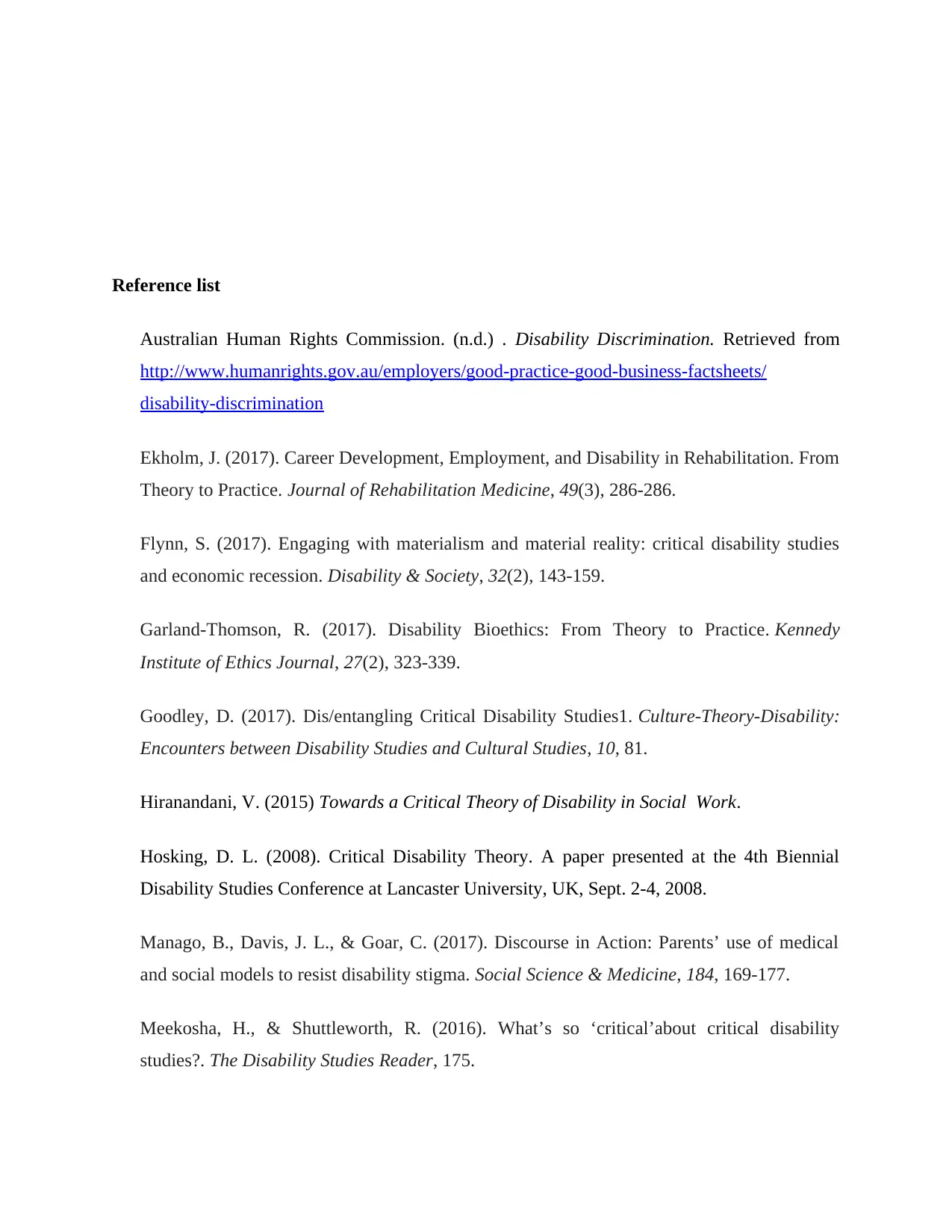
Reference list
Australian Human Rights Commission. (n.d.) . Disability Discrimination. Retrieved from
http://www.humanrights.gov.au/employers/good-practice-good-business-factsheets/
disability-discrimination
Ekholm, J. (2017). Career Development, Employment, and Disability in Rehabilitation. From
Theory to Practice. Journal of Rehabilitation Medicine, 49(3), 286-286.
Flynn, S. (2017). Engaging with materialism and material reality: critical disability studies
and economic recession. Disability & Society, 32(2), 143-159.
Garland-Thomson, R. (2017). Disability Bioethics: From Theory to Practice. Kennedy
Institute of Ethics Journal, 27(2), 323-339.
Goodley, D. (2017). Dis/entangling Critical Disability Studies1. Culture-Theory-Disability:
Encounters between Disability Studies and Cultural Studies, 10, 81.
Hiranandani, V. (2015) Towards a Critical Theory of Disability in Social Work.
Hosking, D. L. (2008). Critical Disability Theory. A paper presented at the 4th Biennial
Disability Studies Conference at Lancaster University, UK, Sept. 2-4, 2008.
Manago, B., Davis, J. L., & Goar, C. (2017). Discourse in Action: Parents’ use of medical
and social models to resist disability stigma. Social Science & Medicine, 184, 169-177.
Meekosha, H., & Shuttleworth, R. (2016). What’s so ‘critical’about critical disability
studies?. The Disability Studies Reader, 175.
Australian Human Rights Commission. (n.d.) . Disability Discrimination. Retrieved from
http://www.humanrights.gov.au/employers/good-practice-good-business-factsheets/
disability-discrimination
Ekholm, J. (2017). Career Development, Employment, and Disability in Rehabilitation. From
Theory to Practice. Journal of Rehabilitation Medicine, 49(3), 286-286.
Flynn, S. (2017). Engaging with materialism and material reality: critical disability studies
and economic recession. Disability & Society, 32(2), 143-159.
Garland-Thomson, R. (2017). Disability Bioethics: From Theory to Practice. Kennedy
Institute of Ethics Journal, 27(2), 323-339.
Goodley, D. (2017). Dis/entangling Critical Disability Studies1. Culture-Theory-Disability:
Encounters between Disability Studies and Cultural Studies, 10, 81.
Hiranandani, V. (2015) Towards a Critical Theory of Disability in Social Work.
Hosking, D. L. (2008). Critical Disability Theory. A paper presented at the 4th Biennial
Disability Studies Conference at Lancaster University, UK, Sept. 2-4, 2008.
Manago, B., Davis, J. L., & Goar, C. (2017). Discourse in Action: Parents’ use of medical
and social models to resist disability stigma. Social Science & Medicine, 184, 169-177.
Meekosha, H., & Shuttleworth, R. (2016). What’s so ‘critical’about critical disability
studies?. The Disability Studies Reader, 175.
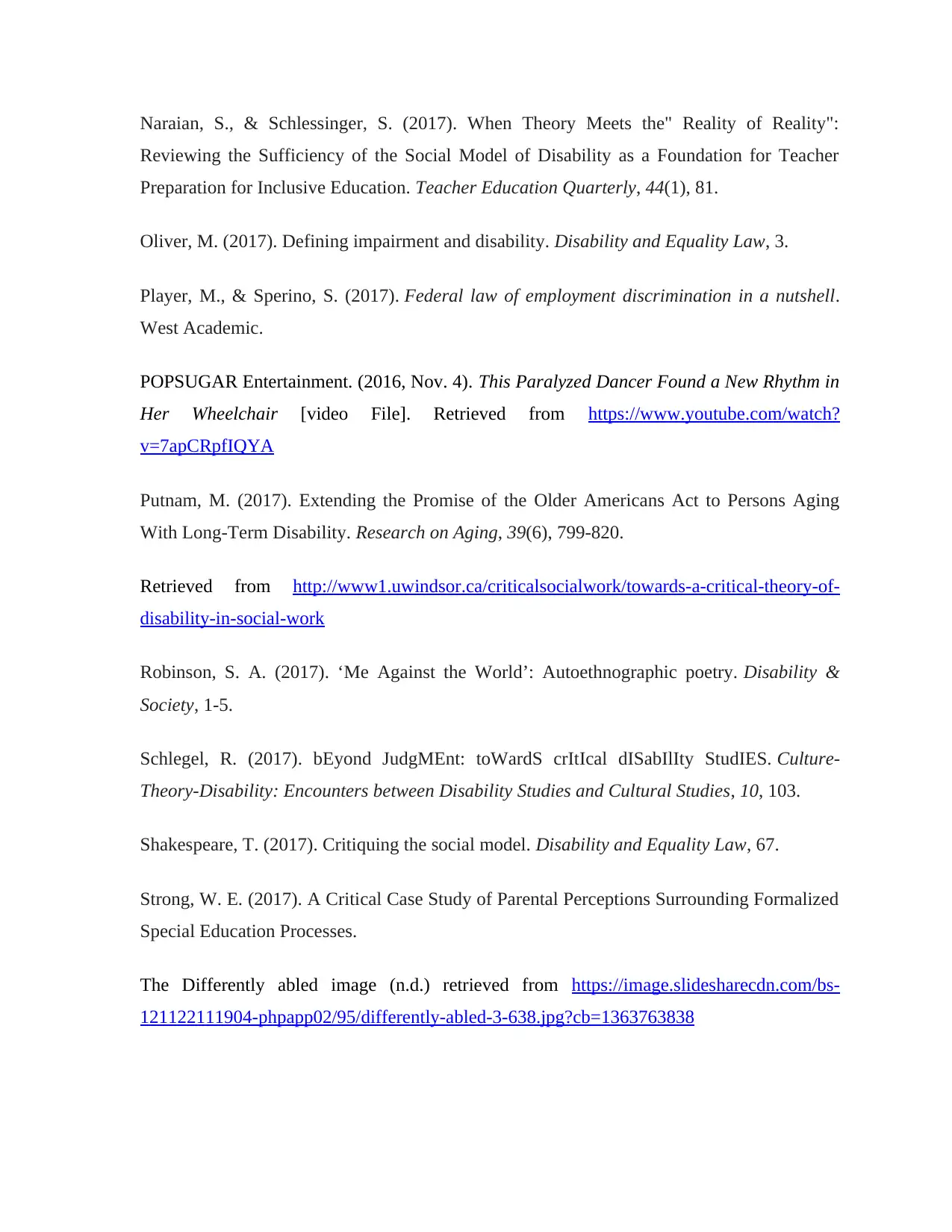
Naraian, S., & Schlessinger, S. (2017). When Theory Meets the" Reality of Reality":
Reviewing the Sufficiency of the Social Model of Disability as a Foundation for Teacher
Preparation for Inclusive Education. Teacher Education Quarterly, 44(1), 81.
Oliver, M. (2017). Defining impairment and disability. Disability and Equality Law, 3.
Player, M., & Sperino, S. (2017). Federal law of employment discrimination in a nutshell.
West Academic.
POPSUGAR Entertainment. (2016, Nov. 4). This Paralyzed Dancer Found a New Rhythm in
Her Wheelchair [video File]. Retrieved from https://www.youtube.com/watch?
v=7apCRpfIQYA
Putnam, M. (2017). Extending the Promise of the Older Americans Act to Persons Aging
With Long-Term Disability. Research on Aging, 39(6), 799-820.
Retrieved from http://www1.uwindsor.ca/criticalsocialwork/towards-a-critical-theory-of-
disability-in-social-work
Robinson, S. A. (2017). ‘Me Against the World’: Autoethnographic poetry. Disability &
Society, 1-5.
Schlegel, R. (2017). bEyond JudgMEnt: toWardS crItIcal dISabIlIty StudIES. Culture-
Theory-Disability: Encounters between Disability Studies and Cultural Studies, 10, 103.
Shakespeare, T. (2017). Critiquing the social model. Disability and Equality Law, 67.
Strong, W. E. (2017). A Critical Case Study of Parental Perceptions Surrounding Formalized
Special Education Processes.
The Differently abled image (n.d.) retrieved from https://image.slidesharecdn.com/bs-
121122111904-phpapp02/95/differently-abled-3-638.jpg?cb=1363763838
Reviewing the Sufficiency of the Social Model of Disability as a Foundation for Teacher
Preparation for Inclusive Education. Teacher Education Quarterly, 44(1), 81.
Oliver, M. (2017). Defining impairment and disability. Disability and Equality Law, 3.
Player, M., & Sperino, S. (2017). Federal law of employment discrimination in a nutshell.
West Academic.
POPSUGAR Entertainment. (2016, Nov. 4). This Paralyzed Dancer Found a New Rhythm in
Her Wheelchair [video File]. Retrieved from https://www.youtube.com/watch?
v=7apCRpfIQYA
Putnam, M. (2017). Extending the Promise of the Older Americans Act to Persons Aging
With Long-Term Disability. Research on Aging, 39(6), 799-820.
Retrieved from http://www1.uwindsor.ca/criticalsocialwork/towards-a-critical-theory-of-
disability-in-social-work
Robinson, S. A. (2017). ‘Me Against the World’: Autoethnographic poetry. Disability &
Society, 1-5.
Schlegel, R. (2017). bEyond JudgMEnt: toWardS crItIcal dISabIlIty StudIES. Culture-
Theory-Disability: Encounters between Disability Studies and Cultural Studies, 10, 103.
Shakespeare, T. (2017). Critiquing the social model. Disability and Equality Law, 67.
Strong, W. E. (2017). A Critical Case Study of Parental Perceptions Surrounding Formalized
Special Education Processes.
The Differently abled image (n.d.) retrieved from https://image.slidesharecdn.com/bs-
121122111904-phpapp02/95/differently-abled-3-638.jpg?cb=1363763838
⊘ This is a preview!⊘
Do you want full access?
Subscribe today to unlock all pages.

Trusted by 1+ million students worldwide
1 out of 13
Related Documents
Your All-in-One AI-Powered Toolkit for Academic Success.
+13062052269
info@desklib.com
Available 24*7 on WhatsApp / Email
![[object Object]](/_next/static/media/star-bottom.7253800d.svg)
Unlock your academic potential
Copyright © 2020–2025 A2Z Services. All Rights Reserved. Developed and managed by ZUCOL.



